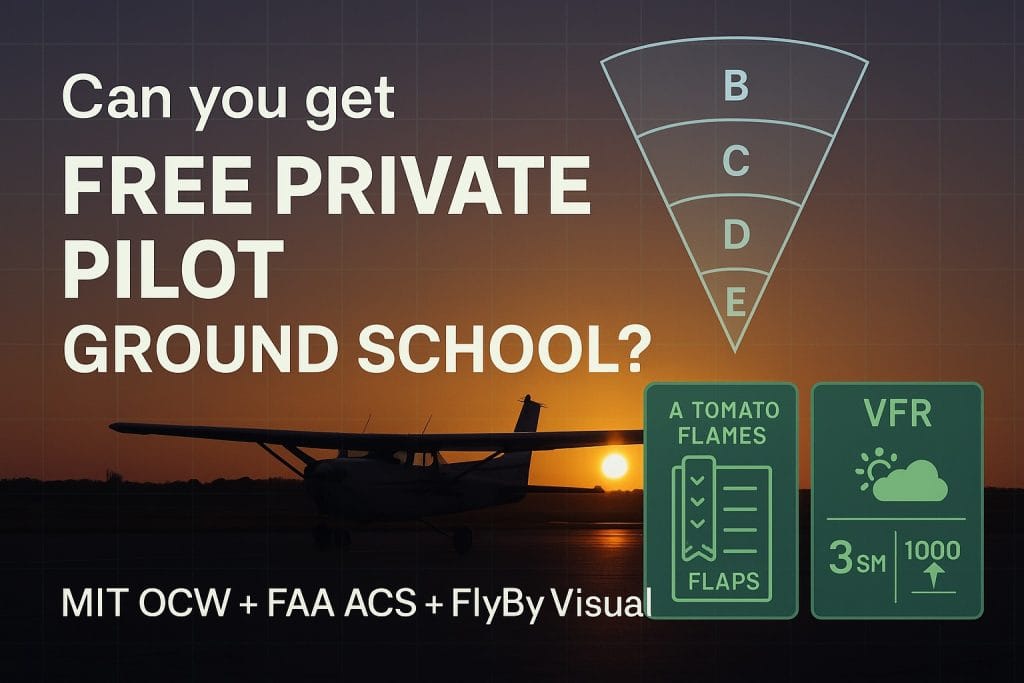Short answer: yes—MIT OpenCourseWare (OCW) hosts a complete Private Pilot Ground School taught by MIT. It’s free, video-based, and pairs beautifully with focused study tools (like Flyby Visual) to prep you for both the FAA knowledge test and smarter flight lessons.
What the MIT course includes (for $0)
- Full video series + slides. 20+ recorded lectures plus downloadable notes covering aerodynamics, systems, airspace, weather, performance, W&B, human factors, flight planning, night ops, and more.
- Structured, intensive format. The class ran as a three-day workshop aimed at preparing students for the FAA Private Pilot Knowledge Test.
- Official FAA reading list. You’ll lean on the free FAA handbooks: the Pilot’s Handbook of Aeronautical Knowledge (PHAK) and the Airplane Flying Handbook (AFH).
- Instructor insights. Clear learning objectives and a strong emphasis on pairing lectures with FAA reading and practice questions.
👉 Explore the course on MIT OCW: https://ocw.mit.edu/courses/16-687-private-pilot-ground-school-january-iap-2019/
Two important caveats
- No endorsement or certificate from OCW. OCW is a public library of course materials—no completion tracking or certificates. You’ll still need an endorsement from an authorized instructor to sit for the knowledge test.
- Mind the “what’s current” gap. The OCW class was recorded in 2019. Always align your prep with the current FAA Airman Certification Standards (ACS). As of 2024, the current PPL Airplane ACS is FAA-S-ACS-6C (effective May 31, 2024).
Bottom line: MIT’s videos are excellent for understanding. Pair them with the current ACS, practice questions using the FAA figure book, and a CFI endorsement.
Will it prepare you for the FAA written?
It can—if you use it the right way. The content breadth maps well to ACS knowledge areas (weather, performance, regulations, navigation). To make it test-ready today, anchor your study to the current ACS and work through modern question banks using the official FAA testing figures. The PAR exam is 60 questions, about 2.5 hours, and 70% to pass.
Your free study plan (MIT OCW + FAA publications + FlyBy Visual)
Week 1 – Foundations
- Watch MIT Lectures 1–6 (Intro, Aerodynamics, Learning to Fly, Systems, Airspace, Environment).
- Read PHAK chapters on Principles of Flight, Aircraft Systems, and Airspace.
- Use FlyBy Visual memory tools for A TOMATO FLAMES/FLAPS, airspace, and aircraft parts.
Week 2 – Weather & Performance
- Watch Lectures 7–13 (Meteorology, Comms & FIS, Ownership, Performance, Interpreting Weather Data).
- Read PHAK Weather Theory and Aviation Weather Services; skim AFH Performance.
- Drill our VFR weather minimums visuals.
Week 3 – Navigation, W&B, Human Factors
- Watch Lectures 14–18 (Nav, Human Factors, Flight Planning, sUAS awareness, Weight & Balance).
- Work MIT slides for weight & balance examples; practice ACS-style problems.
- Use our visual mnemonics for squawk codes and beyond.
Week 4 – Night, Ops, Final Review
- Watch Lectures 19–21 (Night, Weather Minimums & Tips, Multi-engine & jets awareness).
- Map everything to the current ACS task list; do 3–5 full practice exams.
- Meet your CFI for the knowledge test endorsement and to review weak ACS codes.
Where FlyBy Visual helps you crush it
MIT is fantastic for understanding. FlyBy Visual is built to make the memorization parts painless and sticky—especially the topics that show up again and again on the PAR and check rides:
- Weather minimums (VFR): Snap-to visuals tying visibility + cloud clearance to airspace class and altitude bands with day vs. night callouts.
- Regulation mnemonics (equipment): Crystal-clear memory aids for A TOMATO FLAMES (day VFR) and FLAPS (night), plus common gotchas (e.g., position vs. anti-collision lights).
- Airspace, made unforgettable: Memorable visuals making everything airspace easy to recall such as weather minimums, speed limits, and required equipment highlighted (Mode C veil, ADS-B reminders).
Pair the MIT lecture for concept depth with these visuals for instant recall. That combo keeps you aligned to the current ACS while trimming study time and easy-to-miss points.
What MIT OCW doesn’t do (and how to fill the gap)
- Endorse your written: You’ll need a CFI or qualifying ground school to sign you off. Share your practice-test history and ACS-code review for a quick sign-off.
- Issue certificates/credit: OCW offers no credit or certificates—that’s normal for open courseware.
- Guarantee currency: Cross-check any numbers, regs, or “what’s tested” against the current ACS and your instructor’s advice.
Quick links
- MIT Private Pilot Ground School (videos + slides): https://ocw.mit.edu/courses/16-687-private-pilot-ground-school-january-iap-2019/
- FAA Private Pilot – Airplane ACS (FAA-S-ACS-6C) (PDF): https://www.faa.gov/training_testing/testing/acs/private_airplane_acs_6.pdf
- FAA ACS index: https://www.faa.gov/training_testing/testing/acs
- Pilot’s Handbook of Aeronautical Knowledge (PHAK): https://www.faa.gov/regulations_policies/handbooks_manuals/aviation/phak
- Airplane Flying Handbook (AFH): https://www.faa.gov/regulations_policies/handbooks_manuals/aviation/airplane_handbook
- FAA Airman Knowledge Testing Matrix: https://www.faa.gov/training_testing/testing/testing_matrix
- FAA Knowledge Testing overview: https://www.faa.gov/training_testing/testing
Final take: If you’re trying to keep your PPL training financially sane, MIT OCW is one of the highest-value free ground school resources out there. Use it for depth and context, then layer in FlyBy Visual to cement the must-memorize details, align your prep to the current ACS, and get your CFI endorsement. That combo gets you to “pass the written” faster—and into the cockpit with more headspace for flying well.
